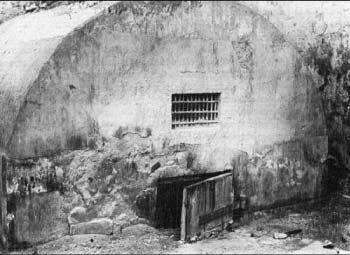There are some appealing stories about the survivors of the May 8th disaster…
 Some of them are completely made up, spreading in some litterature but have never been reported locally, and/or never been investigated thoroughly…( For instance, the story of the little girl Havrila D’afrile)… On the other hand, the accounts of the survivors as reported by the scientists and the journalists who were on the field, are quite interesting. They allow us to understand the nature of the nuee ardente (glowing avalanche) and the extent of the catastrophe.
Some of them are completely made up, spreading in some litterature but have never been reported locally, and/or never been investigated thoroughly…( For instance, the story of the little girl Havrila D’afrile)… On the other hand, the accounts of the survivors as reported by the scientists and the journalists who were on the field, are quite interesting. They allow us to understand the nature of the nuee ardente (glowing avalanche) and the extent of the catastrophe.
Only 2 people who were actually inside the city survived the blast : Cyparis and Leon Compère. Many others who were on the boats anchored in the harbor, or in the neighborhoods around St. Pierre also got caught in the blast and survived. As a matter of fact, the only people who survived the blast (in its direct path), had a shelter inside a building, a jail cell, or in a boat, where the contact with the intense heat of the nuee ardente was limited. On the edges of the  pyroclastic flow, the heat wasn’t high enough and the blast wasn’t strong enough to kill instantly or to cause heavy damages. The account of Mr Lassère and Mr Simonet, leaving St. Pierre to Morne-Rouge on a mule-drawn carriage is quite interesting (from Kennan, 1902):
pyroclastic flow, the heat wasn’t high enough and the blast wasn’t strong enough to kill instantly or to cause heavy damages. The account of Mr Lassère and Mr Simonet, leaving St. Pierre to Morne-Rouge on a mule-drawn carriage is quite interesting (from Kennan, 1902):
“They saw it (the black cloud of the volcano) coming, just as they began the ascent of the Grande Reduit, and lashed their mules into a gallop with the hope of escaping it ; but the eastern edge of it caught them about sixty feet from the crucifix on the top of the hill. It approached with a roaring, “galloping” sound, struck them like a mighty rushing wind ; overturned and completely wrecked their carriage, setting the mules free ; and then swept across the summit of the Grande Reduit, leaving them stunned, burned and half dead in the shattered vehicle. They saw no flame or fire ; did not notice anything like suffocating gas ; and smelled nothing except what they described as the “odor of smoke from lava.” Both felt the intense heat of the blast as it swept over them, but Mr. Lassère did not realize that he was seriously burned until he crawled out of the wrecked carriage. Darkness became quickly afterward, but they succeeded in getting into a small deserted house near the little chapel or shrine, and there they waited until it became light enough so that they could walk to Morne Rouge. Their clothing showed no signs of injury from heat, but their backs were badly burned or scalded under it ; the skin is at once peeled off their hands so that it hung from them in strips ; and when they arrived at Morne Rouge, their shoes had to be cut from their burned and swollen feet.”
Cyparis is probably the most famous survivor of the disaster, since his story was widespread around the world, especially after he got a contract to show his burns in the Barnum & Bailey American circus. G. Kennan (1902) was the first foreigner to meet him while in Morne-Rouge, after he’d been rescued from his cell…
“Cyparis said that the cell he occupied in the St. Pierre prison was an underground dungeon, which had no other window than a grated aperture in the upper part of the door. On the morning of May 8th, while he was waiting for breakfast, it suddenly grew very dark ; and almost immediately afterward hot air, mixed with fine ashes, came in through the door-grating and burned him. He rushed and jumped in agony about the cell and cried for help ; but there was no answer. He heard no noise, saw no fire, and smelled nothing except “what he thought was his own body, burning.” The intense heat lasted only a moment, and during that time he breathed as little as possible. There was no smoke in the cell and the hot air came in through the door-grating without any noticeable rush or blast. He had on, at the time, hat, shirt, and trousers, but no shoes. His clothing did not take fire, and yet his back was very severely burned under his shirt.”
The second survivor in St. Pierre, Leon Compère, is less known. His account has been reported only by professor Alfred Lacroix. His house was located at the bottom of a hill opposing the volcano, so that it didn’t sustain a direct impact from the blast. When the nuee ardente came, Leon Compère found a shelter inside his house under a table. The heat was intense enough to set fire to a woolen sweater hanging at a door. Afterwards, he left the burning building, the whole city was ablaze. He had to walk on the hot volcanic ash to Fonds-St-Denis, a nearby village. He suffered severe burns.
Lacroix. His house was located at the bottom of a hill opposing the volcano, so that it didn’t sustain a direct impact from the blast. When the nuee ardente came, Leon Compère found a shelter inside his house under a table. The heat was intense enough to set fire to a woolen sweater hanging at a door. Afterwards, he left the burning building, the whole city was ablaze. He had to walk on the hot volcanic ash to Fonds-St-Denis, a nearby village. He suffered severe burns.
(Source http://www.mount-pelee.com/en/1902-1905-eruption/survivors-stories.html)



